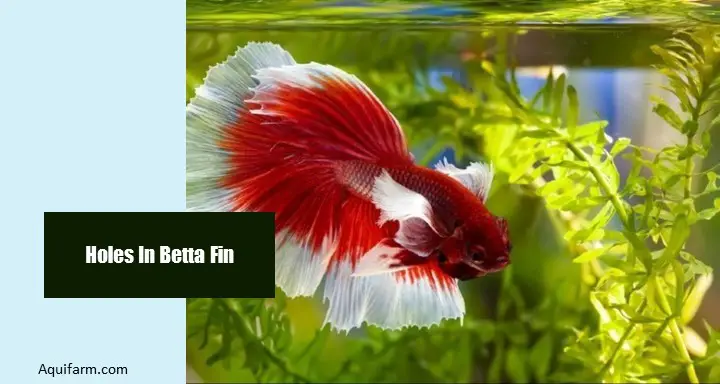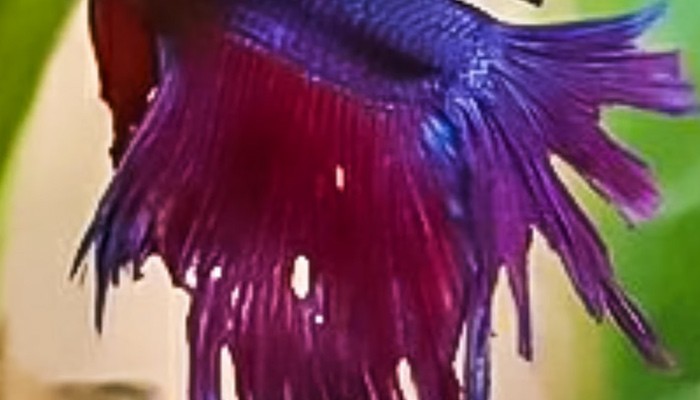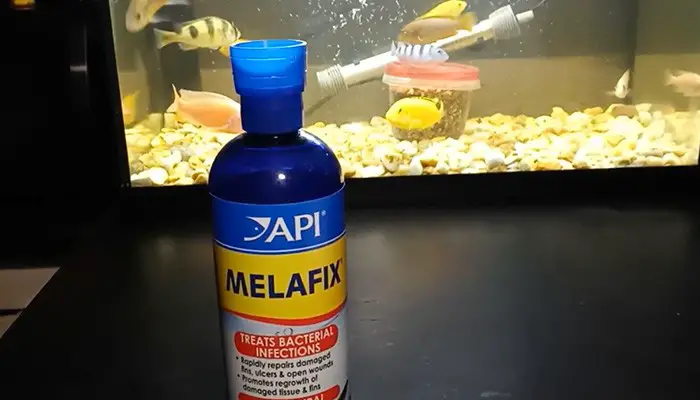
Betta fish are well known for their beautiful, delicate, lacy flowing tails and fins. The estimated lifespan of these depending upon optimum conditions is two to three years. If you are able to keep your betta for quite a while, you might face some issues with their fins or tails.
A blow-out, pinhole in the fins, or fin rot is not impossible for the betta. Apart from bacterial attacks, there might be any problem in your fish tank that may cause these.
There are different probabilities for encountering pinholes in your bettas which include any sharp decoration in your tank, any harassing behavior from other fish either in a friendly or aggressive way, fin rot, bacterial attack, and any disturbance in the tank environment like dirt in the water.
It takes very little to get rid of such an issue. Let us introduce some DIY methods thoroughly.
Why Are There Pinholes In My Betta Fins?

Tears or small holes in betta fish are not an alarming scenario but itchy for sure. It takes quite little to recover such damages. Unless you know the cure and preventive measures, this issue will keep harassing you thoroughly. However, being the least careful is sufficient enough to fight this issue.
1. Decorations In The Tank
One of the simplest reasons behind any pinholes or tears on your betta fin is the decoration of your tank. Since betta fish tends to swim all around your tank, you will find them roaming around every corner of your tank.
While swimming around, betta fins and tails snag on things very easily. And having any rough surface, sharp stuff, incisive stones, etc. might leave your betta fish with scars, pinholes, or tears in the fish fin or tail.
If this happens too randomly, your betta might end up losing its fin or tail. Such scars on them hamper the fin tissues and cause fin ripping.
Treatment (including precautions)
Be aware of any inconvenient stuff for fish while decorating your fish tank. You must not be pleased to have any holes or small tears on the majestic betta fins.
Avoid putting any rough or sharp stones including any other decoration with any spiky ends. Sharp-edged decorations must not be chosen.
Add smoother decorations to your fish tank. Consider live and fish-friendly plants as the fish will love swimming through the jungle. Plant these for better outcomes.
2. Other Fish
Fish compatibility is also important for your tank. You can’t just randomly put a random fish with any killer one. Before housing different types of fish at the same time, be aware of the reciprocal behavior among the types.
While keeping betta fish with other species, you gotta ensure that none of the other fish is neither harassing nor attacking him. It’s usual for smaller but faster fish to harass or fin nip your betta.
If your betta is being attacked, make a separate housing for him or separate other fish from him. While removing the betta make sure that the transaction happens smoothly and your betta doesn’t bother about the new water environment.
Treatment (including precautions)
You must be careful and avoid any fish that will be aggressive to your betta or fin nip while staying in the same tank. While entertaining some more fish to your tank, beware of ensuring a friendly environment.
Facing any aggression toward your betta, you may either have a spare tank ready for a separate housing or use a tank divider for a prompt response. (Our Pick: Shiroumiya Aquarium Fish Tank Divider Isolation Board)
Attacks from other fish may not only cause small pinholes or tears but also complete fin rot. Rather such a disturbing environment is not healthy for your betta as well.
3. Bacterial or Fungal Attack and Fin Rot
If you are putting less effort than required into your tank and leaving it for a longer period without cleaning it, the water environment of your fish tank might be toxic for your fish. There might be a bacterial attack on your bettas.
Dirty or rotten water might give growth to the bacterial attack and fin rot to your bettas. In such an environment the bacteria take over the fin tissue and bring in small pinholes on them.
In terms of bacterial or fungal attack, you will see symptoms like the edge of the fins or tails will have a white shade. They might hold any other color than usual while being infected.
Water temperatures other than 75-80 degrees Fahrenheit will affect your betta and stress it out. That may also lower the immune response of your fish.
Treatment (including precautions)

In the above-mentioned case, all you need to do is to change your tank water regularly and give your some time to your betta to heal its fins and tails.
Maintain a weekly water change schedule for your bettas. Thus the water will remain fresh and the infection rate will notably decrease.
While changing water, keep in mind that at the same time, you need to clean your tank and decorations as well. Before pouring new water into your tank, keep the water in the same room to sync the temperature of the water for your betta.
While scooping your betta out of your tank, take some of the old tank water with him to make him feel comfortable. If you wish to use any antibiotic in your tank, use this. This product will boost the healing time of your fish. (Our Pick: API MELAFIX Freshwater Fish Bacterial Infection Remedy)
In extreme cases go for different medicines for different issues like a fungal or bacterial infection. While using the medicine, you may use a quarantine tank for your bettas.
4. Any Disturbance in The Water
While housing betta, the water plays an important role in the fish’s health. By any chance, if the water gets dirt in it or becomes imbalanced for your betta, your fish will be affected both physically and mentally.
Lack of proper nutrients and excess waste in your fish tank might make your fish stressed. And it can start biting its own tail or fins.
Imbalanced water also gives rise to bacterial attacks. If the situation goes untreated, the issue might even be severe by spreading to the body. Then it becomes harder to treat the fish but not impossible.
Treatment (including precautions)
To fight the water imbalance, you need to change the tank water more often, like 10% of the water on a daily basis. And the full tank of water once a week or twice a week in case of a worse scenario. But don’t continue the later changing rate more than three times. Your fish needs a stable water environment.
Test your tank water and ensure no ammonia in it since ammonia is prone to affect your betta by poisoning it. Even if it doesn’t kill him, it will eventually weaken him and his immune system.
You may try aquarium salt in your tank as well. With this, your betta’s slime coat will be improved. You need to ensure your bettas’ slime coat remains strong while the fin infection is at its peak. Adding aquarium salt will help your betta repel bacterial and fungal infections.
The water conditioner is also an option as your water additive and works as a supplement to aquarium salt. It will also work as a stress reliever for your betta which will reduce the probability of biting his own tail. (Our Pick: API STRESS COAT Aquarium Water Conditioner)
Use the water parameter to check your tank water quality on a regular basis to balance the substances duly. Don’t underestimate the dirty water at all!
Frequently Asked Questions (FAQs)
Will Ripped Betta Fins Heal?
Any defect in your betta fins is more likely recoverable. In most cases, the injury heals on its own. Clean water is sufficient enough unless there are any aggressive fish in the same tank, there is any sharp substance as a decoration or there are any imbalances in the tank water environment. But you can help your fish with a quick recovery by adding aquarium salt or antibiotics as well.
How Long Does It Take For A Betta Fish To Grow Back Fins?
You will be amazed to know that betta fin grows at a similar rate to your fingernail. Thus a betta fish takes a few weeks to a few months to grow a fin back. It depends on the severity of the damage. Any outer support from you will help your fish notably. During the process, if your fish accidentally damages its fin, the healing process will be delayed as a consequence.
What Does An Unhealthy Betta Look Like?
Some signs of unhealthy betta fish are inactivity, loss of appetite, discoloration, and lethargy. The attitude and appearance of a betta is the most significant sign to identify its health condition. Betta is prone to swimming around the tank and quickly moving from one end to another while not resting. If you find your betta otherwise, beware of its health.
How Do You Treat Betta Fins?
If you notice fin rot or fin loss of your betta, you need to be careful about your fish’s health. There might be an issue with the water or any fungal or bacterial attack on your fish. Change the water properly and regularly, feed the fish some foods with vitamin B, and add aquarium salt to make the healing process faster. If necessary, isolate your betta to a quarantine tank while treating.
Conclusion
A blow-out in the betta fins or tails is the pinholes, small tears, or comparatively larger holes on your fish fin or tails. You must not be happy with such a scenario as further escalation to this might take a toll on your fish.
You need to keep your tank clean and free from any sharp-edged decorations. Your tank must not house any hostile fish as well.
Maintain your fish tank water parameters while checking them regularly. Try adding some water additives to your fish tank to increase the water quality.
In most cases, it takes really little to recover the holes on your betta fins. But you cannot ignore them at all. Otherwise, you might have to go for a harder way to treat your bettas and recover them!
- Top 15 Freshwater Aquarium Plant Ideas for a Lush, Green Tank - November 9, 2024
- Top 13 Freshwater Aquarium Layout Ideas for a Beautifully Organized Tank - November 9, 2024
- 14 Stunning Rustic Freshwater Aquarium Ideas for a Tranquil Environment - November 9, 2024
